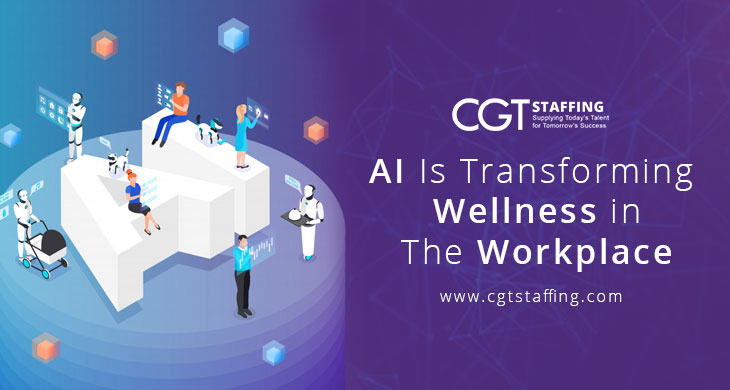Workforce management and human resource functions have been making use of artificial intelligence for some time now. AI has played a huge part in automating many of the monotonous and repetitive processes that erode human productivity. It helps businesses redirect their workforce to tasks that can only be executed effectively by humans. Most recently, with the onset of the COVID-19 pandemic, AI has been at the forefront of the battle, helping medical providers make the best use of strained resources. It makes sense that AI can also be seen transforming wellness in the workplace.
Table of Contents
AI and Its Impact on Wellness in the Workplace
AI has long been associated with optimizing employee productivity in the workplace. Businesses spend significant monies on in-house recruitment as well as an experienced staffing agency to hire the best talent possible. So it is only natural for business leaders to expect the best productivity possible from these workers. Business automation helps free up human workers, allowing them more time to focus on complex, human-only tasks that a machine cannot accomplish. Automation is not the only application AI has in the business in any case. Here’s how AI is helping boost wellness in the workplace in the post-COVID world:
Less Stress with Smarter Workflows
Business AI systems often have the capacity to identify bottlenecks and obstacles in a specific workflow. In the interest of improving productivity, AI can take over many of these tasks and automate them. This does more than just free up human workers for other tasks; it also streamlines the way the workflow proceeds. AI has a larger degree of accuracy than most humans do, which means you will have to spend less time validating the previous steps and more time adding your own role’s value to the process.
AI can also take over many tasks that have been disrupted by the COVID-19 pandemic. From managing calendars to automating social media marketing campaigns, AI can contribute significantly to reduced worker stress and improved focus. HR and third parties, like mortgage recruiters, can leverage any well-known AI systems you use as a benefit of working with you.
Recognizing Distress among Workers
Good businesses aren’t just concerned with the health of their financial statements, but also the health of their employees. Productive workers are usually healthy workers, which means emotional, mental, or physical distress could impair their productivity. Talent acquisition strategies often include discussions on managing mental distress and health, but many employees may still choose to suffer in silence out of a sense of misplaced pride or shame. That means you shouldn’t be relying on workers to come to you every time with their problems.
A distressed worker can only continue to do the job for so long before their distress spills over into their role and performance. AI systems can help monitor and recognize signs of stress among employees passively. From wearables that monitor a worker’s heartbeat and emotional state to passive visual monitoring that picks up on body language, AI is advanced enough to identify and read the right cues. The AI can then alert workforce managers and support services to help employees deal with their problems constructively instead of ignoring them until they become debilitating.
Related: COVID-19 and the Changing Approach to Wellness in the Workplace
Smoothen Workplace Relationships
Smooth workflows and high-performing teams depend heavily on good working relationships. Humans can form admiration and trust among their colleagues during the length of their workplace relationships. But the opposite can also be true, where workers may not trust or like one another very much.
Healthy disagreements should always be encouraged, but when they start to threaten team cohesion and performance appraisals, they may already be out of your control. This usually impacts team morale and worker stress levels in chaotic ways. An AI system can help preempt this and preserve the supportive and friendly culture of your workplace simply by identifying employee friction that needs addressing.
Personalized Health Monitoring and Recommendations
AI can help businesses monitor and track employee health, not just in the workplace, but outside it as well. AI wearable tech can monitor key vital signs and indicators, and integrate them with other monitoring data from various sources in the workplace. This data can then be used to identify employee health issues in real-time, alerting the appropriate managers and teams to spring into action. AI may even be able to predict a health problem before it happens, especially if it has access to a worker’s medical history and data
Of course, getting workers to wear AI technology that monitors things like their emotions, heart rate, blood sugar, and any other indicators should always follow their legal consent. In any case, this is highly personal and confidential data that needs to be kept strictly secure. However, you can do so without any significant changes to your company hierarchy, simply by signing up for vCISO services. Information security consultants with C-level expertise can offer you all the security direction and oversight you need to integrate AI into a healthier and safer workplace.
